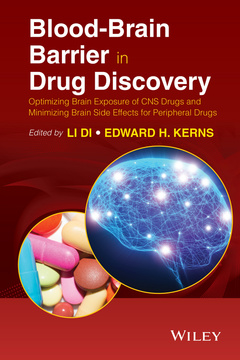Blood-Brain Barrier in Drug Discovery Optimizing Brain Exposure of CNS Drugs and Minimizing Brain Side Effects for Peripheral Drugs
Coordonnateurs : Di Li, Kerns Edward H.

Focused on central nervous system (CNS) drug discovery efforts, this book educates drug researchers about the blood-brain barrier (BBB) so they can affect important improvements in one of the most significant ? and most challenging ? areas of drug discovery.
? Written by world experts to provide practical solutions to increase brain penetration or minimize CNS side-effects
? Reviews state-of-the-art in silico, in vitro, and in vivo tools to assess brain penetration and advanced CNS drug delivery strategies
? Covers BBB physiology, medicinal chemistry design principles, free drug hypothesis for the BBB, and transport mechanisms including passive diffusion, uptake/efflux transporters, and receptor-mediated processes
? Highlights the advances in modelling BBB pharmacokinetics and dynamics relationships (PK/PD) and physiologically-based pharmacokinetics (PBPK)
? Discusses case studies of successful CNS and non-CNS drugs, lessons learned and paths to the market
Contributors ix
Preface xiii
1 Introduction and Overview 1
li di and Edward H. Kerns
Part 1 Pharmacokinetics of Brain Exposure 5
2 Pharmacokinetics of CNS Penetration 7
Andreas Reichel
3 Free Drug Hypothesis for CNS Drug Candidates 42
Xingrong Liu and Cuiping Chen
4 Species Differences and Impact of Disease State on BBB 66
Jean-Marie Nicolas
Part 2 Mechanisms of Drugs Across the Blood–Brain Barrier 95
5 Passive Diffusion Permeability of the BBB—Examples and SAR 97
Scott Summerfield, Phil Jeffrey, Jasminder Sahi, and Liangfu Chen
6 Establishment of P-Glycoprotein Structure–Transport Relationships to Optimize CNS Exposure in Drug Discovery 113
Jerome H. Hochman, Sookhee N. Ha, and Robert P. Sheridan
7 Uptake Transport at the BBB—Examples and SAR 125
Ziqiang Cheng and Qian Liu
8 Transport of Protein and Antibody Therapeutics across the Blood–Brain Barrier 146
William M. Pardridge
Part 3 Predicting and Measuring Brain Exposure of Drugs 167
9 In Silico Tools for Predicting Brain Exposure of Drugs 169
Hongming Chen, Susanne Winiwarter, and Ola Engkvist
10 In Vitro Assays for Assessing BBB Permeability: Artificial Membrane and Cell Culture Models 188
Alex Avdeef, Mária A. Deli, and Winfried Neuhaus
11 Human-Based In Vitro Brain Endothelial Cell Models 238
Hannah K. Wilson and Eric V. Shusta
12 Methods for Assessing Brain Binding 274
li di and Cheng Chang
13 In Vivo Studies of Brain Exposure in Drug Discovery 284
Edward H. Kerns
14 PBPK Modeling Approach for Predictions of Human CNS Drug Brain Distribution 296
Elizabeth C.M. de Lange
15 PK/PD Modeling of CNS Drug Candidates 324
Johan Gabrielsson, Stephan Hjorth, and Lambertus A. Peletier
16 Microdialysis to Assess Free Drug Concentration in Brain 351
William Kielbasa and Robert E. Stratford, Jr.
17 Imaging Techniques for Central Nervous System (CNS) Drug Discovery 365
Lei Zhang and Anabella Villalobos
Part 4 Modulating Brain Penetration of Leads During Drug Discovery 385
18 Designing CNS Drugs for Optimal Brain Exposure 387
Zoran Rankovic
19 Case Studies of CNS Drug Optimization—Medicinal Chemistry and CNS Biology Perspectives 425
Kevin J. Hodgetts
20 Designing Peripheral Drugs for Minimal Brain Exposure 446
Peter Bungay, Sharan Bagal, and Andy Pike
21 Case Studies of Non-CNS Drugs to Minimize Brain Penetration—Nonsedative Antihistamines 463
Andrew Crowe
Part 5 Case Studies in CNS Drug Discovery 483
22 Case Study 1: The Discovery and Development of Perampanel 485
Antonio Laurenza, Jim Ferry, Haichen Yang, Shigeki Hibi, Takahisa Hanada, and Andrew Satlin
23 Case Study 2: The Discovery and Development of the Multimodal Acting Antidepressant Vortioxetine 505
Christoffer Bundgaard, Alan L. Pehrson, Connie Sánchez, and Benny Bang-Andersen
Part 6 Drug Delivery Techniques to CNS 521
24 Brain Delivery Using Nanotechnology 523
Huile Gao and Xinguo Jiang
25 Intranasal Delivery to the Central Nervous System 535
Lisbeth Illum
Part 7 Future Prospects in Blood-Brain Barrier Understanding and Drug Discovery 567
26 Future Perspectives 569
N. Joan Abbott
Index 580
Li Di is an associate research fellow in the Pharmacokinetics, Dynamics, and Drug Metabolism Department at Pfizer Global Research and Development and has extensive experience in the pharmaceutical industry. She has over 100 publications, presented over 70 invited lectures, and teaches an American Chemical Society short course on drug-like properties.
Edward Kerns worked in pharmaceutical research and development for over 30 years, was associate director at Wyeth and Bristol-Myers Squibb, then was at the NIH-National Center for Advancing Translational Sciences. He published over 90 journal papers or book chapters and 3 books, and teaches an American Chemical Society short course on drug-like properties.
Date de parution : 02-2015
Ouvrage de 600 p.
16x23.4 cm
Thèmes de Blood-Brain Barrier in Drug Discovery :
Mots-clés :
Blood-brain barrier (BBB); medicinal chemistry; central nervous system (CNS); drug discovery; brain pharmacokinetics and pharmacodynamics (PK/PD); brain physiologically-based pharmacokinetics (PBPK); BBB transporters; P-glycoprotein (P-gp); breast cancer resistant protein (BCRP); brain penetration; brain permeability
